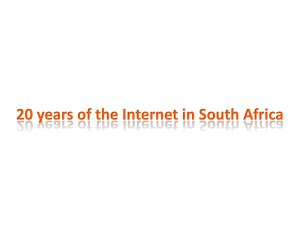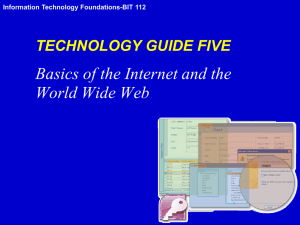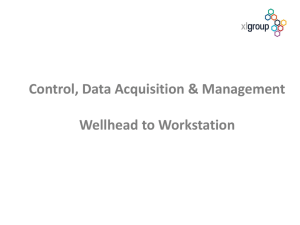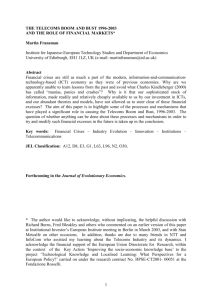Lecture 1
advertisement
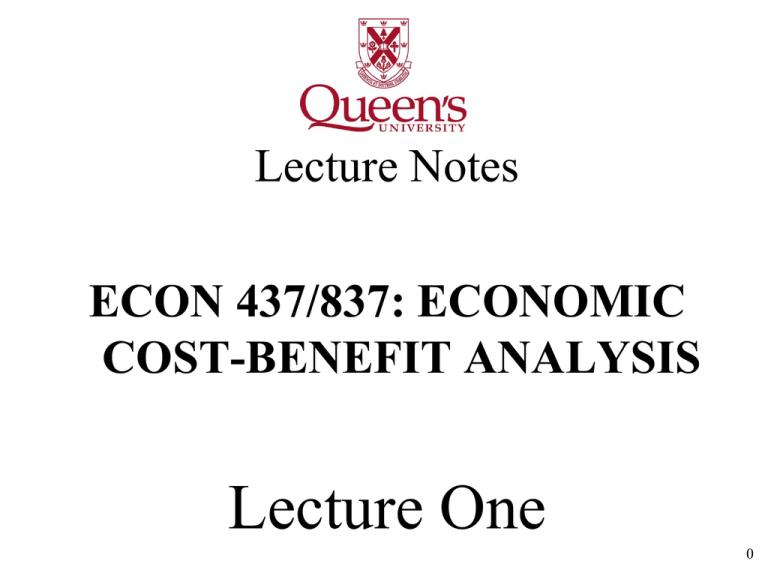
Lecture Notes ECON 437/837: ECONOMIC COST-BENEFIT ANALYSIS Lecture One 0 COST-BENEFIT ANALYSIS: An Integrated Approach 1 The Role of Investment Appraisal • To stop bad projects – bad policies • To prevent good projects from being destroyed • To determine if components of projects are consistent • To assess the sources and magnitudes of risks • To determine how to reduce risks and efficiently share risks 2 Questions addressed by an Integrated Investment Appraisal • Is the project financially viable or fiscally sustainable? • Does the project contribute to the economic growth of the country? i.e., positive expected economic NPV? • Who are beneficiaries of project and by how much? • Who are the interest groups (stakeholders) who could distort the investment decision or affect the project’s performance? • What are the sources and magnitudes of risk? • What are the risks associated with the benefits accruing to the stakeholders? Sources of political risks? • Are poverty alleviation goals being addressed? • What are the fiscal impacts? • What is the personality of the project? 3 Impact of Analysis • Quality of analysis has been shown by the World Bank to be a key determinant of the success of a project’s performance. • A proper analysis will cause the project to be redesigned so that it is less likely to fail. • World Bank experience shows that the probability of failure for poorly prepared projects within 3 years of a project’s life is 7 times that of well-prepared projects. • Poorly prepared projects have 16 times as high a probability of failure within 5 years as compared to wellprepared projects. 4 Incrementality of Projects • One of the important concepts when defining a project is to measure the impact of the project’s cash flows and net benefits and costs on an incremental basis. • We should carefully identify the benefits and costs that are only associated with the project, and not include any other benefits that would exist “WITHOUT” the project being undertaken. • It is normal for the benefits and costs to change over time for the “WITHOUT” project case. • The “WITHOUT” project scenario must be properly defined before using it as the base case from which to measure incremental benefits and costs produced by the “WITH” project case. • It is an optimized “WITHOUT” project situation that should be compared with the “WITH” project situation to calculate the incremental benefits and costs. • There is another perspective “before the project” versus “after the project” scenarios. “Before the project” is NOT the appropriate base case from which to measure incremental benefits and costs. 5 Project Cycle: Stages in Project Appraisal A. Idea and Project Definition B. Pre-Feasibility Study C. Feasibility and Financing D. Detailed Design E. Project Implementation F. Ex-Post Evaluation 6 A. Key Questions at Idea Stage a. Where is the demand? b. Is this project consistent with the organization’s expertise, current plans and strategy for the future? Can the project be implemented and operated in a reasonably efficient matter? 7 Project Definition • Project definition is defined broadly to include the scope and specification of the objectives of the project, its output, its different stakeholders, its economic and social benefits, and the data requirements. • Most of the project’s data requirements are identified in the pre-feasibility and feasibility stages of the project where the project’s variables and parameters are analyzed in detail. 8 B. Pre-Feasibility Study • Examines overall potential of project • Should maintain same quality of information across all variables • Wherever possible should use secondary information Key questions: a. Is this project financially and economically feasible throughout the project’s life? b. What are the key variables? c. What are the sources of risk? d. How can the risk be reduced? 9 C. Feasibility Study • Focus is on improving accuracy of the key variables • Alternatives for reducing risk are examined in detail • Some primary data may be needed Key questions: a. Is project financially attractive to all interested parties in activity? b. What is level of uncertainty of key variables? c. How is the project financed? d. Can final decision for approval be taken? 10 Modules of Pre-Feasibility and Feasibility Studies The data for a pre-feasibility study are generally arranged in what is referred to as “building blocks” because they constitute the foundation for the different types of analyses. Building Blocks: A. Demand Module B. Technical Module C. Environmental Assessment Module D. Human Resources and Administrative Support Module E. Institutional Module Analysis Modules: F. Financial/Budget Module G. Economic Module H. Social Appraisal or Distributive and Basic Needs Analysis 11 Building Block A: Demand Module • Study of sources of demand, nature of market, prices and quantities • Major distinction between domestic versus internationally traded goods and services • For internationally traded goods, prices are given to the project by world markets – Secondary information most important • For domestic market, primary research more important Output of Module: a. Forecast of quantities and real prices for project life b. Taxes, tariffs, subsidies, public regulations, technological trends c. Environmental impacts 12 Building Block B: Technical Module • A study of input requirements for investment and operations and their costs • In this module, secondary information can be used very effectively • Need to avoid conflict of interest between supplier of technical information and seller of investment equipment, or contractor for construction Output of Module: a. Technology and life of project b. Quantities of inputs by type needed for investment and operation c. Labor required by type and time d. Input prices and sources of supply e. Environmental impacts 13 Building Block C: Environmental Assessment Module • Environmental assessment augments information for the economic analysis • Identification of environmental impacts and risks • Where possible, quantify the environmental impacts Key Questions: a. What are the likely environmental impacts from undertaking project? b. What is the cost of reducing the negative impact? c. Are the environmental impacts and risks with and without technical measures taken to reduce these impacts? d. Are there alternative ways of supplying the good or service of project without incurring these environmental costs? What are the costs of these alternatives? 14 Building Block D: Human Resources and Administrative Support Module • What are managerial and labor needs of the project? • Does organization have the ability to get the managerial skills needed? • Is timing of project consistent with quantity and quality of management? • What are wage rates for labor skills required? • Manpower requirements by category are reconciled with availabilities and project timing. 15 Building Block E: Institutional Module • This module deals with the adequacy of the institution responsible for managing the different stages or phases of the project. • Insufficient attention to the institutional aspects creates serious problems during the implementation and operation phases of the project. Key Questions: a. Is the entity that is supposed to manage the project properly organized and its management adequately equipped to handle the project? b. Are the capabilities and facilities being properly utilized? c. Is there a need for changes in the policy and institutional set up outside this entity? What changes may be needed in policies of the local, regional and central governments? 16 Analysis Module F: Financial Module What is done: • Integration of financial and technical variables from demand module, technical module, and management module • Construct cash flow profile of project • Identify key variables for doing economic analysis Key questions: a. What is relative certainty of financial variables? b. What are sources and costs of financing? c. What are minimum cash flow requirements for each of the stakeholders? d. What can be adjusted to satisfy each of the stakeholders? 17 Analysis Module G: Economic Module What is done: • Examines the project using the whole country as the accounting entity • Evaluation of externalities including environmental Key questions: a. What are differences between financial and economic values for a variable? b. What causes these differences? c. With what degrees of certainty do we know values of these differences? d. What is the expected value of economic net benefits? e. What is the probability of positive economic feasibility? 18 Analysis Module H: Stakeholders and Basic Needs Analysis What is done: • Identification and quantification of extra-economic impacts of project • Income, cost, and fiscal impacts on various stakeholders • Poverty alleviation and political necessities • Basic Needs: Evaluate the impact of project on achieving basic needs objectives – Basic needs will vary from country to country Key Questions: a. In what ways does project generate beneficial and cost impacts on stakeholders? b. c. d. e. f. g. What stakeholders could the project impact? Who benefit and who pay the costs? What are the basic needs of the society that are relevant in the country? What impact will the project have on basic needs? What alternative ways are there to generate desirable social impacts? Is project relatively cost effective in generation of desirable social impacts? 19 Integrated Projects • Integrated projects can get very complex and need to be approached cautiously to avoid costly errors. • It is possible for the bundled project to be financially and economically viable even though some of the components are not. • Dropping the components that generate negative returns will maximize the project’s benefits. • Defining and understanding the objectives of the project is particularly important when analyzing integrated projects. • Ultimately, the ‘bundle’ that succeeds the most in accomplishing the desired objectives should be undertaken. • If the objective of the project is to maximize the wealth of people in country, then the component or bundle that yields the highest economic NPV should be undertaken. 20 ECONOMIC VALUE ECONOMIC VALUE = FINANCIAL VALUE = + TAX IMPACT + NET BENEFITS TO CONSUMERS + NET LABOUR BENEFITS FINANCIAL VALUE TAX IMPACT NET LABOUR BENEFITS NET BENEFITS TO CONSUMERS 21 General Relationship NPVECOeco. dr= NPVFINeco. dr+ PVEXTeco. dr - Holds when all benefits and costs are discounted using same discount rate. 22 Alternative Points of View • Critical in analysis: to evaluate financial outcome of project from the point of view of each interested party • Conventional analysis considers: a. Point of view of owner b. Point of view of all investors combined (Banker’s point of view or total investment point of view) c. Point of view of economy Other Perspectives: • • • • Point of view of government budget Point of view of suppliers of inputs Point of view of downstream processors Point of view of competitors Analyses of Investment Decisions from Alternative Points of View Type of Analysis Financial Economic (I) (II) (III) (IV) Banker (Total Investment) Yes No/Yes Yes No Owner Yes No/Yes Yes No Government Budget Office Yes No/Yes Yes No Country No Yes Yes Yes Viewpoint: Stakeholder Basic Needs 24 Analyses of Investment Decisions from Different Viewpoints Note: Exchange premium=10%; Receipts & Equipment 100% tradable; Tradable Operating cost =100 Analysis Financial Economic Financial Banker’s (Total Viewpoints: Year: Investment) Owner Country Govt. Budget (A) (B) (C) (D) 0 1 0 1 0 1 0 1 Receipts 400 400 440 40 Operating Cost -140 -140 -150 -10 Equipment -1000 Operating Subsidy Taxes 950 -1000 950 -1100 1045 -100 95 50 50 -50 -100 -100 100 Loan 500 Interest -500 -50 Environ. Externality -190 Opp. Cost of Land -30 -30 -30 -30 -30 -30 Net Resource Flow -1030 1130 -530 580 -1130 1115 -100 175 Summary of Project Decision Criteria 1. Financial NPV 2. Financial IRR 3. Annual DSCRs 4. LLCRs 5. Economic NPV 6. Economic IRR 7. PV of impact on stakeholders 8. Probability of unacceptable outcome Project Owner’s View Banker’s View Country’s View Distribution Analysis for each of indicators above (risk simulation) Risk Analysis 26 APPRAISAL OF REGIONAL AFRICAN SATELLITE PROJECT RASCOMSTAR-QAF 27 Objectives of Project i) Expand telephone coverage into rural areas of Africa by providing an alternative way of connectivity to telecom operators ii) Interconnect existing public switch telephone networks (PSTNs) otherwise known as fixed lines iii) Provide bandwidth lease service (BLS) to internet providers and TV broadcasters 28 Objectives of Appraisal 1) Does project ensure the least-cost way of expanding telecommunication services in Africa? 2) What is magnitude of financial benefits realized by RSQ and telecom operators? 3) What are cashflow implications for RSQ in terms of servicing its debt obligations? 4) To what extent does this project contribute to African economy? 5) Who are stakeholders and by how much do they benefit, or lose, as a consequence of project? 6) What are risk factors that affect project and how can uncertainty and risk exposure be mitigated? 29 Rural Telephony Service (TES) ▪ Allow African telecom operators to expand their coverage over hard-to-reach rural areas ▪ Telecom operators will deploy terminals in phone booths, tele-centers, private or residential sites in rural areas 30 Connectivity on-demand (TRS: Trunking Service) PSTN City x gateway Terrestrial PSTN Infrastructure Regional City gateway n ? Regional gateway Gateway PSTN PSTN Regional City gateway 2 Mission Control Center ▪ Through satellite, participating African telecoms can link directly with each other, instead of resorting to costly international satellites ▪ In order to participate in the exchange, telecoms need to install gateways that will link their existing telephone networks with that of other countries via the satellite 31 Bandwidth Lease Service (BLS) GSM Backhaul ▪ This service targets TV broadcasters, internet service providers and big corporations with fixed annual subscriptions ▪ Services include trunking, broadcasting, internet services, global system of mobile communication (GSM) backhauling, private or corporate networks and news gathering services 32 Project Cost and Financing • Total capital cost is estimated at US$ 357 m in 2005 prices - Space segment (e.g., satellite) and ground segment (e.g., gateway) • Financing - Equity: US$ 151 m - Loans - LAFB: US$ 85 m, nominal interest rate is 4.68% p.a. - AfDB, IsDB, EIB, etc.: US$ 126 m, interest rate is 4.68% p.a. • Timing and Project Life - Construction of satellite started in June 2003 - Satellite launched in October 2006 - Operation starts in January 2007 for 15 years 33 Project Cost and Financing (cont’d) Satellite Launcher Insurance Ground control system Launch campaign, LEOP, IOT/Scc/ttc (Ariane) Ground design Ground infrastructure development Terminals Other ICS and BLS development Pre operating expenses License fees Contingencies Total capital expenditure A B C A A D E F 2003 35.9 4.6 3.5 1.1 12.2 3.0 60.3 2004 40.7 5.2 4.0 3.2 4.4 57.5 2005 2006 27.6 15.6 2.0 46.0 4.2 38.2 3.5 2.0 2.7 1.5 10.2 33.0 20.5 4.7 1.6 6.3 3.9 0.8 2.3 82.4 144.0 2007 Total 119.8 7.0 55.0 42.5 15.3 11.7 4.2 43.2 20.5 6.3 4.8 31.5 3.0 3.0 11.8 355.9 34 Key Assumptions • Decrease in real TES,TRS tariffs per annum at 7.32% • Decrease in real annual charge for BLS transponders 2.5% per year • Transponders not used by TES and TRS are sold to BLS subscribers at a discount: capacity of satellite is fully used at all times • US inflation rate 2.5% (base case) • Daily traffic per terminal 70 minutes/day in 2007 increases to 74 in 2008 and stays constant thereafter • No liquidation value for satellite • Real opportunity cost of equity capital of 15% per year 35 RSQ’s Cash Flow Statement Real, 2005 Prices (US$ million) Year INFLOW TES TRS BLS Change in accounts receivable Residual value Total Inflow OUTFLOW Investment Costs Operating Costs General operating costs Labor Change in accounts payable Change in cash balance Income tax Total Outflow NET CASH FLOW BEFORE FINANCING Add: Loan disbursement Less: Loan repayment plus interest NET CASH FLOW AFTER FINANCING 2003 2004 2005 - - - 63.1 59.2 82.4 63.1 59.2 - -63.1 24.5 1.2 -59.2 52.9 0.1 -39.8 -6.4 2006 140.5 - 2007 2008 2009 2010 2011 2012 2013 2014 2015 2016 2017 2018 1.9 5.3 38.2 -10.5 34.9 29.6 8.9 34.0 -6.6 65.8 57.9 67.8 66.7 62.3 16.4 19.8 19.8 19.6 28.3 24.9 23.5 22.4 -7.6 -3.2 -0.4 0.3 95.0 109.4 109.6 104.7 57.7 19.5 21.4 0.4 99.0 53.5 18.6 20.7 0.5 93.2 49.6 17.5 20.1 0.5 87.6 45.9 16.5 19.4 0.4 82.4 42.6 16.4 18.8 0.2 78.0 39.6 16.3 18.3 0.2 74.3 11.5 - - - - - - - - - - - 12.9 12.9 2.8 2.8 0.0 0.0 0.0 0.0 1.0 1.7 16.7 17.4 11.9 2.8 0.1 -0.1 2.1 16.8 10.8 2.8 0.1 -0.1 2.1 15.7 9.7 2.8 0.1 -0.1 2.1 14.5 8.6 2.8 0.1 -0.1 2.0 13.4 7.6 2.8 0.1 -0.1 1.9 12.3 6.6 2.9 0.1 -0.1 1.8 11.3 6.0 2.9 0.0 -0.1 1.7 10.6 5.5 2.9 0.0 -0.1 1.6 10.0 5.0 2.9 0.0 -0.1 1.6 9.5 2.7 2.7 85.1 143.2 13.1 2.7 -1.5 2.0 0.0 27.8 -85.1 -143.2 10.4 109.3 0.0 1.3 7.1 14.8 3.2 49.1 77.6 2 43.4 92.6 40.6 93.9 37.9 90.2 35.3 85.6 32.8 80.9 30.4 76.4 14.0 71.7 13.0 68.0 12.0 64.8 - -74.7 18.8 47.4 34.2 51.9 56.0 54.8 52.8 50.5 62.3 58.7 56.0 64.8 -35.3 ADSCR - - - - - - - - 1.79 2.28 2.48 2.55 2.61 2.66 5.45 - - - - - LLCR - - - - - - - - 2.76 2.99 3.17 3.38 3.69 4.23 5.54 - - - - - FNPV @ ROE FIRR: 15% Real: 20.8% Real 75.6 US$ million 36 Telecoms’ Cost and Financing ▪ Telecoms will purchase and install terminals and gateways ▪ Total cost of telecoms participation in project is US$ 253 m in 2005 prices ▪ Assumed that telecoms will finance their investment costs by equity ▪ Subscription of terminals is expected at 13,240 by 2007 and increase to 94,288 by year 2012 ▪ Telecoms are responsible for maintenance of rural terminals and gateways ▪ Telecoms pay RSQ for airtime on both outgoing and incoming calls; but they collect revenue only on outgoing calls ▪ Telecoms’ real cost of funds (equity) is 15% per year 37 Telecoms’ Cash flow Statement Real, 2005 Prices (US$ million) Year INFLOWS TES TRS Change in accounts receivable Residual values Total Inflows OUTFLOWS Investment Cost Operating Cost Airtime cost Operating & maintenance costs Labor Change in accounts payable Change in cash balance Income tax Total Outflows NET CASH FLOW 2007 2008 2009 2010 4.4 68.9 134.7 157.7 22.2 36.9 68.5 82.6 -6.2 -19.0 -25.5 -14.3 20.5 86.8 177.8 226.0 19.9 42.5 111.0 56.1 7.2 38.5 74.4 87.6 3.0 9.3 25.7 33.5 1.5 3.7 7.8 9.8 -2.7 -9.2 -13.3 -5.9 1.8 6.0 8.6 3.8 4.5 16.1 27.9 31.4 35.2 106.8 242.1 216.4 -14.7 -20.0 -64.3 9.6 2011 2021 2022 155.7 146.3 137.7 129.7 122.3 115.3 111.9 109.2 106.5 103.9 101.4 82.4 81.9 81.2 77.3 73.4 72.9 72.3 71.8 70.6 69.2 67.8 -6.3 -4.4 -4.3 -3.4 -3.2 -3.8 -4.4 -4.4 -4.2 -4.1 -4.0 231.9 223.8 214.6 203.6 192.4 184.4 179.9 176.6 173.0 169.1 165.2 34.3 53.4 87.7 17.0 2012 3.1 2013 2014 1.5 0.6 2015 2016 2017 0.4 0.4 0.4 2018 2019 2020 0.4 0.2 0.1 0.1 - 86.5 81.9 77.2 72.0 67.1 62.5 59.0 55.9 54.6 53.3 52.1 35.2 34.8 34.2 33.5 32.7 32.0 31.2 30.5 29.8 29.1 28.4 10.3 10.2 10.2 10.1 10.0 9.9 9.8 9.7 9.7 9.6 9.5 -1.0 0.4 0.5 0.7 0.7 0.6 0.4 0.3 -0.1 -0.1 -0.1 20.3 0.7 -0.3 -0.4 -0.5 -0.4 -0.4 -0.3 -0.2 0.0 0.0 0.0 -13.2 30.2 28.7 27.6 26.0 24.4 23.8 24.0 24.2 23.7 23.2 22.6 178.8 159.0 150.8 142.4 134.8 128.8 124.5 120.8 117.9 115.2 112.6 7.1 53.0 64.8 63.7 61.2 57.7 55.6 55.3 55.7 55.0 53.9 52.6 80.6 FNPV @ ROE 15% Real: 102.4 US$ million FIRR: 37.3% 38 Key Issues in Economic Analysis • Economic analysis from point of view of whole African continent • Economic value for TES rural users is measured by examining the willingness to pay by end users • Benefits: coping costs decline at 9% p.a. for TES service and 7.32 % p.a. for TRS service; hence net economic benefits decline every year • Cost savings in TES and TRS are fully passed through to end users by telecoms • Real economic cost of capital is 11% per year in Africa • Foreign exchange premium 9% in Africa 39 Economic Resource Flow Statement Real, 2005 Prices (US$ million) Year BENEFITS TES TRS BLS Change in accounts receivable Residual values Total Benefits COSTS INVESTMENT COSTS RSQ Telecoms OPERATING COSTS RSQ Operating & maintenance costs Labor Change in accounts payable Change in cash balance Telecoms Operating & maintenance costs Labor Change in accounts payable Change in cash balance Net benefits flown out of the African continent Total Costs NET RESOURCE FLOW 2003 2004 2005 - - - 67.9 - 63.6 - 86.8 - - - - - - - 67.9 -67.9 63.6 -63.6 2006 - 2007 2008 2009 2010 2011 2012 2013 2014 14.9 227.8 439.7 508.2 494.6 456.7 420.1 386.7 50.3 83.5 155.0 186.8 186.5 185.2 183.7 175.0 48.4 42.8 36.9 33.4 31.8 30.7 58.9 86.2 -26.2 -55.5 -64.0 -22.3 3.6 9.3 2.3 3.4 87.4 298.6 567.5 706.0 716.5 681.9 665.0 651.3 147.2 - - 285.5 266.9 249.9 234.2 156.5 153.9 150.9 147.8 182.2 24.4 23.7 23.1 -0.2 41.3 4.8 4.5 93.5 54.8 624.0 486.5 429.3 409.6 148.3 16.0 2.9 1.3 0.5 0.3 0.3 0.3 0.3 0.2 0.1 0.1 14.7 2.6 0.0 0.0 14.6 2.6 0.0 0.0 13.3 2.6 0.1 -0.1 12.0 2.6 0.2 -0.1 10.6 2.6 0.2 -0.1 9.3 2.6 0.2 -0.1 8.0 2.6 0.1 -0.1 7.2 2.6 0.1 -0.1 6.6 2.7 0.1 -0.1 6.0 2.7 0.1 -0.1 5.5 2.7 0.1 0.0 5.3 2.7 0.0 0.0 5.1 2.7 0.0 0.0 4.9 2.7 0.0 0.0 - - 14.8 2.5 -1.7 2.0 - 2.8 1.4 -0.6 1.8 8.7 3.5 -1.4 6.0 24.2 7.3 -3.6 8.6 31.5 9.2 -1.7 3.8 33.1 9.7 -0.4 0.7 32.7 9.6 0.1 -0.3 32.1 9.5 0.1 -0.4 31.4 9.4 0.2 -0.5 30.7 9.4 0.2 -0.4 30.0 9.3 0.2 -0.4 29.4 9.2 0.2 -0.3 28.7 9.1 0.2 -0.2 28.0 9.0 0.2 0.0 27.3 9.0 0.2 0.0 26.7 8.9 0.2 0.0 - 89.3 149.8 -89.3 -149.8 - 305.6 157.7 160.1 0.1 623.5 52.8 2.5 - 328.2 158.8 136.7 2.2 626.0 2022 39.6 104.5 - - 356.2 165.2 112.1 3.3 636.8 2019 2020 2021 12.5 18.8 2.5 - 2015 2016 2017 2018 - - - - - 0.6 -0.7 6.2 -13.2 3.4 24.7 39.5 47.2 47.9 46.0 43.7 41.4 38.9 36.6 34.7 33.1 32.0 31.2 30.5 57.7 98.6 197.9 158.8 121.4 104.3 98.4 93.2 89.0 85.2 82.1 79.3 77.4 75.6 73.9 -7.1 29.6 200.0 369.7 547.3 595.0 577.6 566.6 558.1 547.8 540.7 541.3 544.7 409.1 353.7 335.6 155.4 ENPV @ EOCK 11% EIRR: 2,338.3 US$ million 45.8% 40 Distribution of Project Net Benefits (US$ million in 2005 prices) • Stakeholders: - Rural Users: $ 1,387.3 m - PSTN Users: $ 460.5 m - BLS Subscribers: $ 212.8 m - Governments: $ 26.8 m Total Externalities: $ 2,087.5 m • Investors other than foreigners: $ 251.9 m 41 Sources of Risk • Risk variation in project outcomes because of uncertainty in key project variables • Main contributors to this variation include: i) Annual real decrease in tariffs ii) Daily traffic per terminal iii) Deployment of terminals iv) Investment cost over-runs Nature of Risk • There is a high uncertainty surrounding annual rate of real tariff reduction. New technologies will cause tariffs to fall faster than expected • Usage rate of terminals is critical and uncertain • Actual deployment of terminals may be different from the subscriptions received from telecoms operators • Investment cost may exceed the amount estimated 42 Risk Assumptions 43 Risk Analysis Outcome: FNPV RSQ Forecast: Financial NPV (RSQ) 9,912 Trials Frequency Chart .023 232 .018 174 .012 116 .006 58 Mean = 46.41 .000 0 -7.69 17.95 43.58 69.21 94.85 Certainty is 0.67% from -7.69 to 0.00 US$ ▪ Expected value is US$ 46.4 m ▪ Probability of FNPV being less than zero is 0.7% ▪ Maximum possible loss is US$ 7.7 m, about 1.7% of investment value ▪ Maximum possible gain is US$ 94.9 m, about 21.6% of investment value 44 Risk Analysis Outcome: FNPV Telecoms Forecast: Financial NPV (Telecoms) 9,889 Trials Frequency Chart .024 239 .018 179.2 .012 119.5 .006 59.75 Mean = 79.30 .000 0 23.85 48.95 74.05 99.15 124.24 US$ ▪ Expected value is US$ 79.3 m ▪ Probability of FNPV being less than zero is 0% ▪ Minimum possible gain is US$ 23.9 m, about 9.7% of investment value ▪ Maximum possible gain is US$ 124.2 m, about 51.5% of investment value 45 Results of Risk Analysis RSQ NPV (US$ m) Deterministic Value Annual Debt Service Coverage Ratio 2009 2010 2011 2012 2013 Loan Life Cover Ratio 2014 2009 2010 2011 2012 75.6 1.79 2.28 2.48 2.55 2.61 2.66 2.76 2.99 3.17 3.38 Mean 46.4 1.55 2.03 2.28 2.43 2.58 2.73 2.60 2.86 3.11 3.40 Standard Deviation 19.1 0.20 0.25 0.28 0.29 0.30 0.31 0.18 0.22 0.27 0.31 Range Minimum -7.7 1.01 1.33 1.31 1.54 1.64 1.75 2.07 2.28 2.18 2.40 Range Maximum 94.9 2.04 2.71 3.32 3.50 3.99 4.50 3.09 3.45 4.24 4.97 Prob. Unacceptable 0.6% 0% 0% 0.1% 0% 0.1% 0% Rsik Statistics 0.0% 0.0% 0.0% 0.1% 46 Risk Mitigation Measures ▪ RSQ can manage cost over-runs by using turn-key contracts ▪ RSQ should get long-term commitment from telecoms and assist them in deploying terminals quickly ▪ RSQ may be able to negotiate a price floor on TES rates for an extended period of time (e.g. five years due to large economic benefits to consumers) ▪ Governments might be approached to give volume guarantee on TES usage 47 Conclusion • Financial and economic outcomes indicate that project is a viable project • The net cash flows seem enough to service its debts to lenders • Telecoms should be willing to participate in project • Net impact on stakeholders is positive, indicating project will improve the economic well-being of Africa as a whole • Great economic impact on rural Africa • Although project is financially and economically viable, there is risk that project sponsors may not be fully compensated for their investment 48
